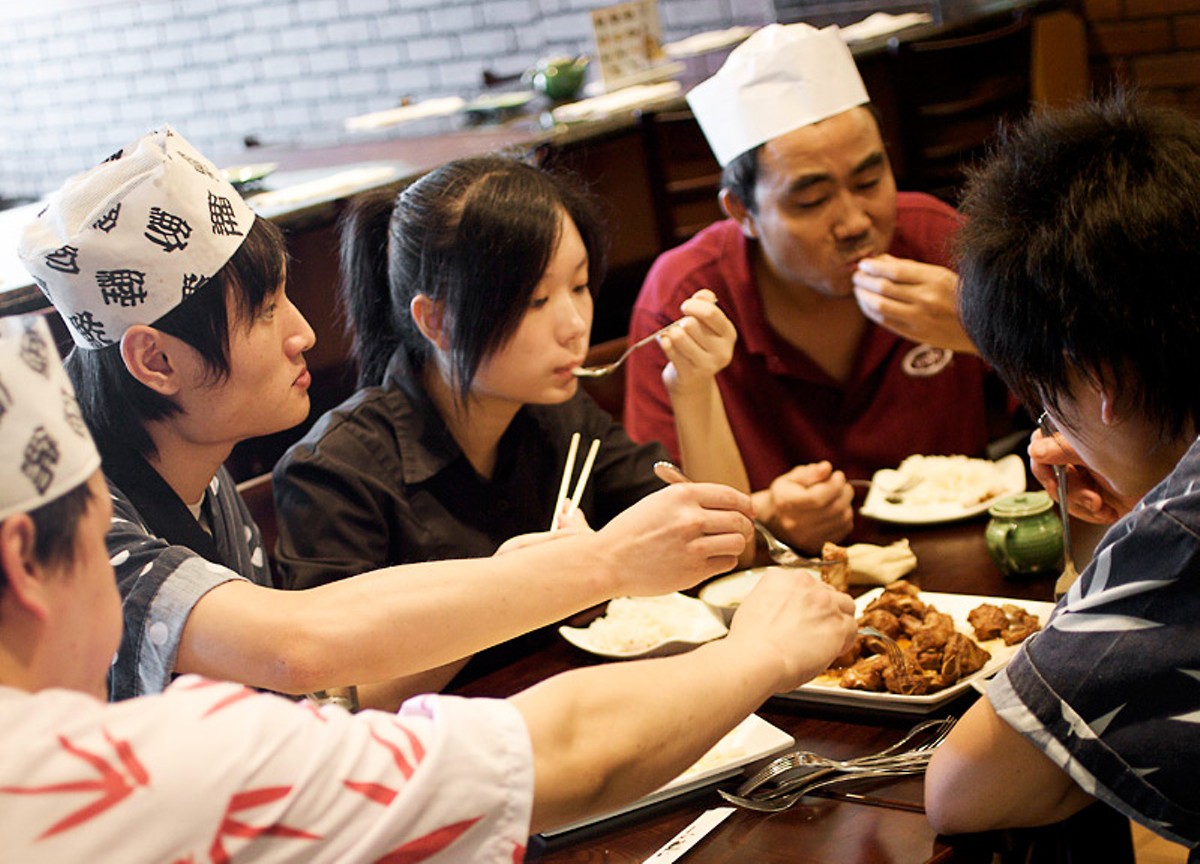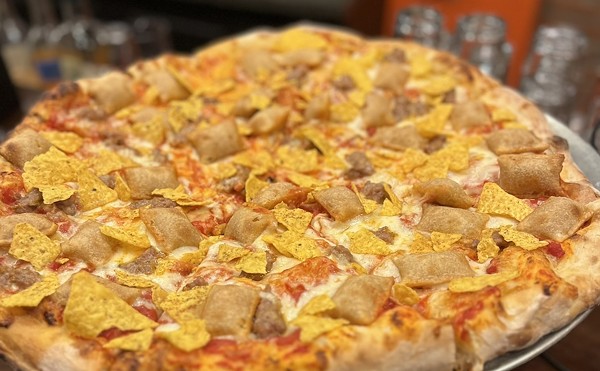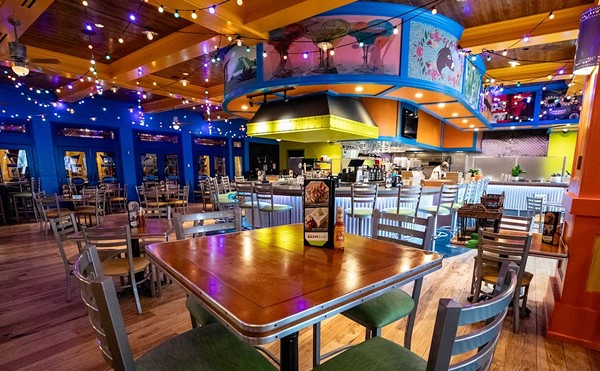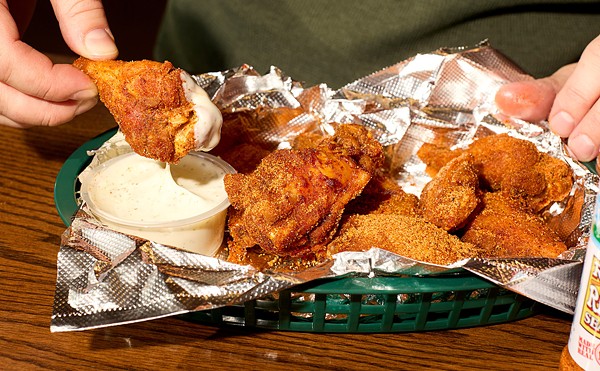In theory, all-you-can-eat sushi is a terrifying concept, the death blow to a noble cuisine struck by the imperialist reach of gluttonous America. I imagine spider rolls as long as party subs, whole tuna loins carved tableside, wasabi paste sculpted into life-size swans, competitive-eating champ Joey "Jaws" Chestnut rolling up to a sushi bar and single-handedly depopulating the world's salmon stock. I remember the first sushi I ever ate, at a basement restaurant in Madrid, of all places, a piece of octopus so fresh that I thought I could feel its tentacle wrapping around my tongue as I chewed, and I weep.
In practice — at Sushi Ai in Maryland Heights, at least — all-you-can-eat sushi is a prosaic affair. If you select the all-you-can-eat option, you mark your choices from a list of nigiri sushi, rolls and appetizers like a bowl of miso soup or skewers of yakitori chicken. When you finish your first round of sushi, you mark your next set of choices on a fresh list. The cost is $11.99 per person at lunch, $15.99 at dinner.
The caveat is that you must clean your plate. Seriously. If you think you can handle one more "Volcano Roll" but, after a couple of bites, realize you are full, you must pay the à la carte price for the roll (or whatever you can't finish) on top of the set all-you-can-eat price. I suppose you can try to avoid the surcharge by hiding any unfinished sushi in your pockets, but anyone who has left salmon in their pants overnight will tell you that you do so at your own peril.
Sushi Ai opened this spring in the strip mall at the intersection of Dorsett and McKelvey roads, just west of Interstate 270. Its appearance is essentially the same as every other strip-mall sushi joint in America, from the neon Sapporo sign in the front window to the glossy picture-menu on each table. Though only a few months old, Sushi Ai has a lived-in, if not secondhand, vibe: The restaurant feels as if it has been here for years.
On my visits most diners availed themselves of the all-you-can-eat option. The young, black-clad waitstaff trooped back and forth from the tables to the sushi bar, bringing lists to the chefs and returning with artfully arranged platters both modest and buffet-size. (The chefs are quite efficient: Even during the lunch rush, I waited no more than ten minutes for my orders.) You might as well eat all you can, too. Unless you want nothing more than, say, a couple pieces of nigiri sushi and a cucumber roll, the all-you-can-eat menu is a good value, and the few dishes that aren't available on it you likely won't miss.
Even by its own minimalist standards, the nigiri sushi here is strikingly straightforward. Not one of the several pieces I sampled carried even a wisp of wasabi paste between fish and rice. That rice is beautifully formed, by the way, very lightly seasoned with rice vinegar and a temperature between the room itself and the human hand.
The fish quality varies. The old standbys, tuna and salmon, are insipid, their flavors clean without any hint of sweetness. (The fattier cuts of tuna are available only à la carte. This is for the best, as market-price otoro, the fattiest cut, is from the bluefin tuna, overfished to the point where the wild population is on the brink of collapse.) I had better luck with yellowtail (hamachi), which has a lovely, pure flavor, lightly sweet, and mackerel, like a smack of the ocean, briny and oily. Unagi is unagi, broiled eel in a soy sauce-dark, sweet barbecue sauce. Octopus is chewy.
Rolls are the usual suspects: California and Philadelphia, spider and rainbow. The aforementioned volcano roll is a blend of tuna, salmon and yellowtail — each described on the menu as "spicy" — on the inside; atop the roll is bright orange masago (smelt roe) and squirts of Sriracha sauce. The result packs a decent chile heat, not overwhelming but certainly enough to obscure the fact that you're eating fish.
There's a selection of "Special Rolls" that aren't available on the all-you-can-eat menu, but for the most part these are variations on established rolls. The "World Series" roll, for example, is sort of a cross between a spider and a rainbow roll, with tempura-fried soft-shell crab inside and an alternating pattern of tuna, unagi and avocado on top. The result is pleasant enough but hardly "special."
I'm certainly not the first critic — locally, let alone nationally — to note the proliferation of sushi restaurants in recent years. Even here, in the middle of the country, sushi has become an ingrained part of our dining habits, and St. Louis accommodates everything from old-school practitioners like Nobu's in University City to creative younger chefs like those at Clayton's Miso on Meramec and Tani Sushi Bistro, with dozens of humble strip-mall joints and sleek sushi lounges in between.
Simply put, sushi isn't special anymore. It's a commodity, and Sushi Ai's all-you-can-eat option is nothing more — nor less — than a convenience.
Dismiss this as the carping of someone paid to think too much about what and where he eats, but there is a serious practical implication. I mentioned that bluefin tuna, source of luscious otoro, is on the brink of collapse as a species. If you consult the Monterey Bay Aquarium's Seafood Watch, a guide to sustainable seafood (available online and also as a smart-phone app), you'll learn that several common nigiri sushi are labeled as "Avoid": octopus, eel, yellowtail, red snapper. Some additional species' suitability depends on the source (farmed or wild) or the method of fishing, information that any given restaurant might not be able to provide.
Should we stop eating sushi? That is a drastic step, and one I'm not qualified to recommend. But it is clearly time to question our apparently insatiable love for sushi. And when your server returns with a fresh order sheet, it's high time we learn when to say, "No, thank you. I've had enough."






